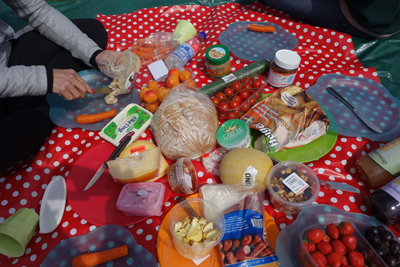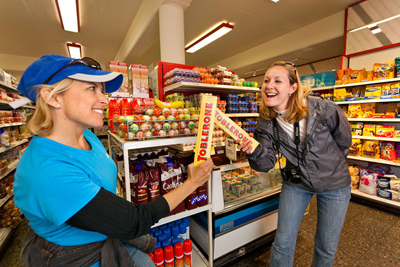Eating local: Shopping for a European picnic
If you want to eat like a local -- enjoying tasty local specialties economically -- picnic. While I'm the first to admit that restaurant meals are an important aspect of any culture, in Europe I picnic almost daily. This is not solely for budgetary reasons. It's fun to dive into a marketplace and deal with locals in the corner grocery or market. And Europeans are great picnickers. Many picnics become potlucks, resulting in new friends, as well as full stomachs.
To busy sightseers, restaurants can be time-consuming and frustrating. After waiting to be served, tangling with a menu, and consuming a budget-threatening meal, you walk away feeling unsatisfied, knowing your money could have done much more for your stomach if you had invested it in a picnic instead.
To bolster your budget, I recommend picnic dinners every few nights. At home, we save time and money by raiding the refrigerator to assemble a pickup dinner. In Europe, rather than raiding the fridge, raid the corner deli, bakery, or supermarket. If your hotelier posts signs prohibiting picnicking in rooms (most likely in France), you'll easily be able to find plenty of other atmospheric places to eat. But if you picnic in your room anyway, be discreet and toss your garbage in a public waste receptacle.
While I like to frequent local bakeries and outdoor markets, American-style supermarkets are a good alternative. Many of them occupy the bottom floor of big-city department stores, and some of them are very upscale. Here are some tips on how to navigate them.
READY-MADE FOOD: Many supermarkets offer cheap packaged sandwiches, while others have deli counters where you can get a sandwich made to order. Just point to what you want. Most supermarkets offer a good selection of freshly prepared quiche, fried chicken, and fish, all for takeout.
PRODUCE: Don't be intimidated by the produce section. It's a cinch to buy a tiny amount of fruit or vegetables. Many have an easy push-button pricing system: Put the banana on the scale, push the picture of a banana (or enter the banana bin number), and a sticky price tag prints out. You could weigh and sticker a single grape. In Spain and Italy, if there is no one to serve you, the store provides disposable plastic gloves for you to wear while picking out your produce (a bare hand is a no-no).
DRINKS: Milk in the dairy section is always cheap and available in quarter, half, or whole liters. Be sure it's normal drinking milk. Strange white-liquid dairy products in look-alike milk cartons abound, ruining the milk-and-cookie dreams of careless tourists. Or look on the (unrefrigerated) shelves for the common-in-Europe but rarer-in-America "long life" milk. This milk -- which requires no refrigeration until it's opened -- will never go bad ... or taste good.
European yogurt is delicious and can often be drunk right out of its container. Fruit juice comes in handy liter boxes (look for "100 percent juice" or "no sugar" to avoid Kool-Aid clones). Buy cheap by the liter, and use a reusable half-liter plastic mineral-water bottle (usually found next to the soft drinks) to store what you can't comfortably drink in one sitting. If it's hot outside, don't expect the soft drinks, beer, or wine to be chilled -- most supermarkets sell these at room temperature.
SWEETS: To satisfy your sweet tooth (or stock up on gifts for the folks back home), check out the dessert and candy section. European-style "biscuits" (cookies) are usually a good value, as are candy bars that might cost twice as much at airport gift shops.
SUPERMARKET ETIQUETTE: Bring your own shopping bag or use your empty daypack, or expect to pay extra for the store's plastic bags. You may even have to pay a euro to use a shopping cart -- although you'll get your deposit back when you return the cart to its rack. Sometimes the store's plastic shopping baskets will have wheels and pull-out handles as a handy alternative.
It's easiest to pay cash at checkout, but if you want to use your credit card, be sure you know the PIN -- the clerk may ask you to enter it (clerks may also ask for photo ID). No one will bag your groceries for you; expect to be bagging and paying at the same time. It's smart to start bagging immediately to avoid frustrating the shoppers behind you.
There is nothing second-class about using a supermarket for a picnic. A few special touches will even make your budget meal a first-class affair. In a park in Paris, on a Norwegian ferry, high in the Alps, at an autobahn rest stop, on your convent rooftop, or in your hotel room, picnicking is the budget traveler's key to cheap and local eating.
(Rick Steves (www.ricksteves.com) writes European travel guidebooks and hosts travel shows on public television and public radio. Email him c/o ITN and follow his blog on Facebook.)


